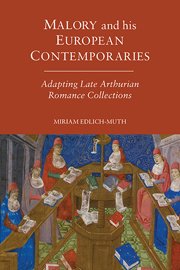Book contents
- Frontmatter
- Dedication
- Contents
- Colophon
- Acknowledgements
- Introduction
- 1 The Adaptation Process
- 2 Style and Narrative Strategy
- 3 Chronological and Genealogical Structures in the Morte Darthur, the Buch der Abenteuer and the Tavola Ritonda
- 4 Narrative Plot Development in the Morte Darthur, the Buch der Abenteuer and the Tavola Ritonda
- 5 ‘The Best Knight in the World’: Adapting Character Constellations
- Conclusion
- Appendix: Note on the Texts and Manuscripts
- Bibliography
- Index
- Arthurian Studies
5 - ‘The Best Knight in the World’: Adapting Character Constellations
Published online by Cambridge University Press: 05 March 2014
- Frontmatter
- Dedication
- Contents
- Colophon
- Acknowledgements
- Introduction
- 1 The Adaptation Process
- 2 Style and Narrative Strategy
- 3 Chronological and Genealogical Structures in the Morte Darthur, the Buch der Abenteuer and the Tavola Ritonda
- 4 Narrative Plot Development in the Morte Darthur, the Buch der Abenteuer and the Tavola Ritonda
- 5 ‘The Best Knight in the World’: Adapting Character Constellations
- Conclusion
- Appendix: Note on the Texts and Manuscripts
- Bibliography
- Index
- Arthurian Studies
Summary
‘And this day I sey ye ar the beste knyght in the worlde, for ye have slayne this day in my syght the myghtyeste man and the beste knyght excepte you that ever I sawe –’
(Morte, p. 162, fol. 103v)One of the striking differences between the very earliest Arthurian works and their fifteenth-century counterparts is the number and variety of characters that populate Arthur's court. Where eleventh-century depictions of the king portray him with a retinue of two or three knights, later descriptions of Camelot contain whole clans of knights, with a wide range of backgrounds and allegiances. Clearly, the introduction of new characters, as well as the interpolation, combination or integration of heroes and storylines from different traditions, is a key method by which Arthurian chronographies were created and expanded. Thus the Morte combines the Vulgate Cycle with the prose Tristan, adding decisive new storylines such as Gareth's expanded adventures. Meanwhile, Gonnot's BN.fr.112 interlaces a wide array of sources including the prose Lancelot and the prose Tristan, and the Buch combines Wolfram's Parzival and Albrecht's Der Juengere Titurel with a redaction of the French prose Lancelot, adding in several other German protagonists of both known and unknown provenance. In contrast, the Tavola is the fairly straightforward result of combining the prose Tristan as its main source with a heavily abridged redaction of the Mort Artu and elements from unknown sources, while the Dutch Lancelot compiler places Dutch-derived protagonists such as Moriaen alongside French-derived protagonists such as Lancelot and Walewein.
- Type
- Chapter
- Information
- Malory and his European ContemporariesAdapting Late Arthurian Romance, pp. 116 - 146Publisher: Boydell & BrewerPrint publication year: 2014



